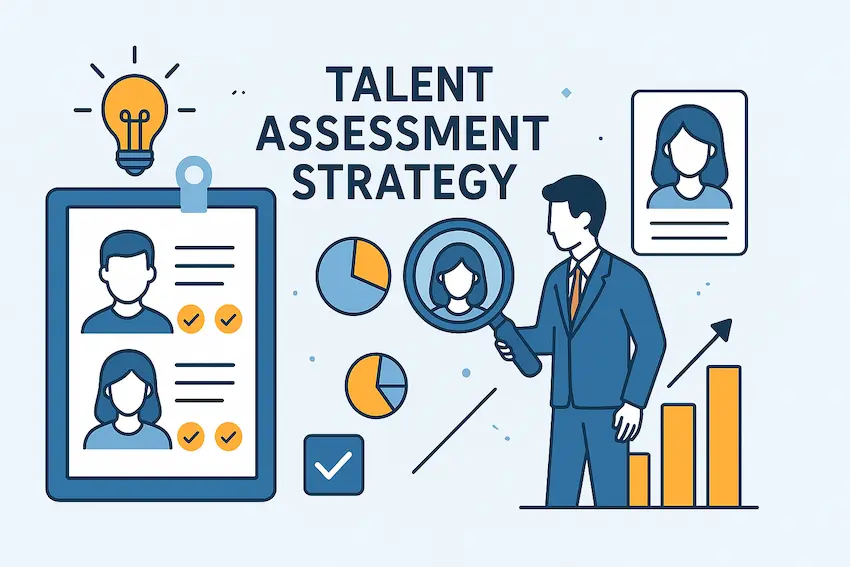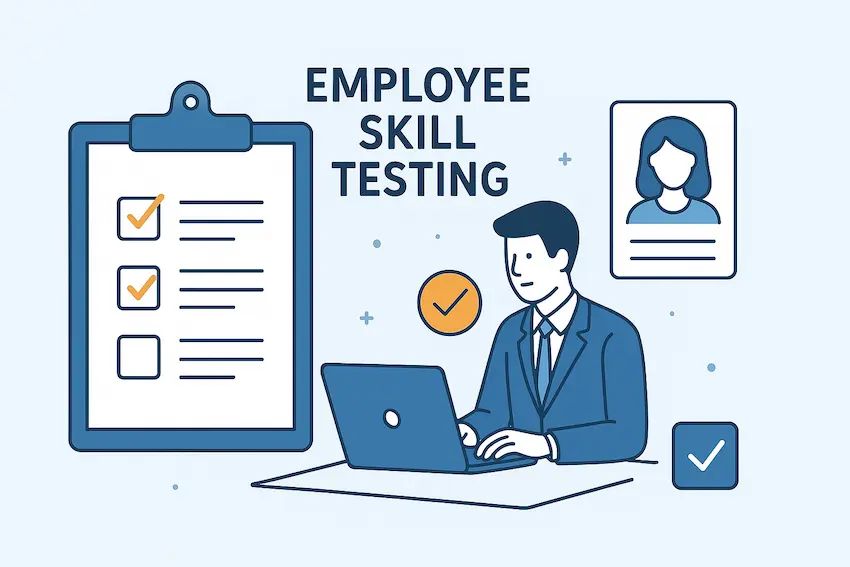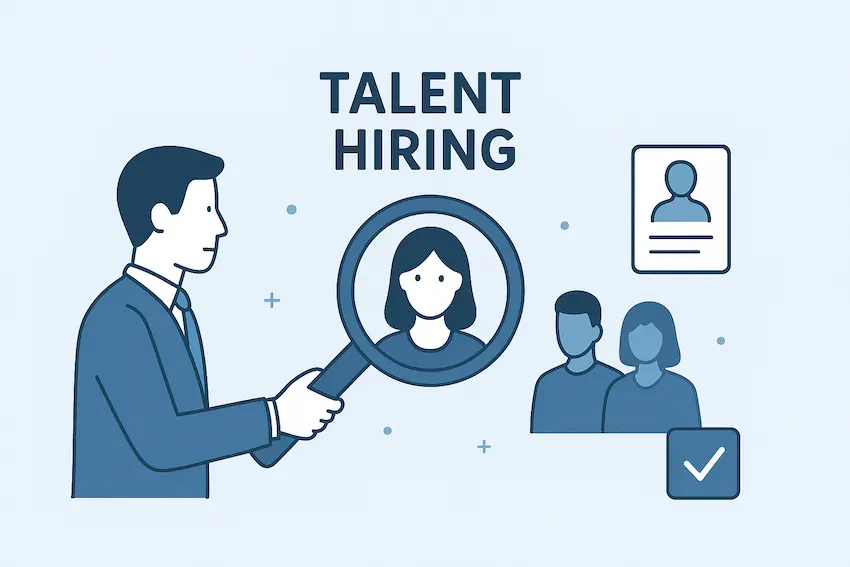A solid talent assessment strategy isn’t just HR jargon thrown around in boardrooms. It’s your secret weapon for building teams that actually deliver results. Let’s dive into why every smart HR manager needs one and how to build it right.
- What Exactly Is a Talent Assessment Strategy?
- Why Your Company Desperately Needs This
- The Game-Changing CAD Framework: Your 10-Dimension Blueprint
- How to Build Your Talent Assessment Strategy?
- How OnlineExamMaker Enpowers Talent Assessments?
- The Tech Advantage: AI in Talent Assessment
- Common Pitfalls to Avoid
What Exactly Is a Talent Assessment Strategy?
Think of a talent evaluation framework as your GPS for people decisions. Instead of wandering around hoping you’ll stumble upon great talent, you get a clear roadmap that shows you exactly what to look for, where to find it, and how to develop it.
At its core, this strategy evaluates four key areas:
- Skills – Can they actually do the job?
- Competencies – Do they have the right behavioral patterns?
- Potential – Where can they grow?
- Cultural Fit – Will they thrive in your environment?

Why Your Company Desperately Needs This
Let’s be brutally honest. Bad hires are expensive. We’re talking about costs that would make your CFO weep – think recruitment fees, training investments, lost productivity, and the domino effect on team morale.
But here’s where it gets interesting. Companies with strategic employee skills assessment processes see some pretty impressive results:
- 50% better hiring decisions (because you’re not just going with gut feelings)
- Dramatically improved workforce performance
- Lower turnover rates (happy employees stick around)
- Faster time-to-productivity for new hires
OnlineExamMaker – Best AI-Powered Exam Creator for Talent Assessments
Still spend a lot of time in creating a talent assessment to assess skills of candidates? OnlineExamMaker is an AI assessment maker that leverages artificial intelligence to help users create quizzes, tests, and assessments quickly and efficiently. You can start by inputting a topic or specific details into the OnlineExamMaker AI Question Generator, and the AI will generate a set of questions almost instantly. It also offers the option to include answer explanations, which can be short or detailed, helping learners understand their mistakes.
What you may like:
● Automatic grading and insightful reports. Real-time results and interactive feedback for quiz-takers.
● The exams are automatically graded with the results instantly, so that teachers can save time and effort in grading.
● LockDown Browser to restrict browser activity during quizzes to prevent students searching answers on search engines or other software.
● OnlineExamMaker API offers private access for developers to extract your exam data back into your system automatically.
Create Your Next Quiz/Exam with OnlineExamMaker
The Game-Changing CAD Framework: Your 10-Dimension Blueprint
Here’s where things get really interesting. Forget those one-size-fits-all assessment tools. The Talent Assessment and Development (CAD) framework gives you ten distinct dimensions to work with. Why ten? Because people are complex, and oversimplified assessments miss the mark.
1. Skills: The Technical Foundation
We’re talking hard skills here – the technical abilities someone needs to get stuff done. Can your Python developer actually code in Python? Does your marketing manager know how to run Facebook ads? It sounds obvious, but you’d be surprised how often this gets overlooked in favor of “cultural fit.”
2. Behaviors: How They Show Up
This is where personality meets performance. Do they have a growth mindset? Are they natural collaborators or lone wolves? Do they bring positive energy or drain it from the room? These behavioral patterns often determine success more than technical skills.
3. Experiences: The Story They Bring
Past experiences shape future performance. But here’s the twist – it’s not just about what they’ve done; it’s about what they need to experience next to reach their potential. Think of it as career GPS.
4. Education and Knowledge: Beyond the Degree
Sure, formal education matters. But in our rapidly changing world, informal learning often trumps traditional credentials. Are they constantly upskilling? Do they consume industry content? This dimension captures both.

5. Contributions and Accomplishments: Real Impact
Here’s where we separate the talkers from the doers. Forget job descriptions – what have they actually accomplished? What tangible value have they created? This data is searchable, measurable, and incredibly revealing.
6. Activities: Time Management Mastery
How someone spends their time tells you everything about their priorities and capacity. If they’re juggling multiple high-impact projects, how are they managing it all? This dimension reveals both efficiency and potential burnout risks.
7. Relationships: The Network Effect
No one succeeds in isolation. Do they have the right professional relationships to get things done? Are they over-networked or under-connected? Understanding their relationship portfolio is crucial for role placement.
8. Passion and Purpose: The Motivation Engine
When someone’s work aligns with their deeper purpose, magic happens. This dimension captures what truly drives them and predicts long-term engagement and performance.
9. Compensation Expectations: The Reality Check
Let’s talk money without being awkward about it. What’s the organization willing to pay versus what the individual expects? Getting this alignment right prevents future disappointments.
10. Benefits and Wellness: The Holistic View
Modern talent cares about more than paychecks. Work-life balance, remote options, wellness programs – these factors increasingly determine whether top talent stays or goes.
How to Build Your Talent Assessment Strategy?
Step 1: Audit Your Current State
Before you build something new, understand what you’re working with. What assessment tools do you currently use? How effective are they? Where are the gaps?
Step 2: Define Success Metrics
What does great performance look like in your organization? Create clear, measurable criteria for each role level and department.
Step 3: Choose Your Assessment Mix
Different roles need different evaluation approaches:
- Personality assessments for culture fit
- Skills testing for technical competencies
- Behavioral interviews for soft skills
- Job simulations for real-world performance
- Emotional intelligence tests for leadership roles
Step 4: Implement Gradually
Don’t try to revolutionize everything overnight. Start with one department or role type, refine your process, then scale.
Step 5: Train Your Team
The best assessment strategy fails if your hiring managers don’t know how to use it effectively. Invest in training.
How OnlineExamMaker Empowers Talent Assessments?
OnlineExamMaker is a versatile online assessment platform designed for creating, delivering, and analyzing quizzes, tests, and surveys. It stands out in talent assessments—such as skills evaluations, job knowledge tests, and career development reviews—by leveraging AI, automation, and robust security features to streamline HR processes and uncover candidate potential.
Create Your Next Quiz/Exam with OnlineExamMaker
Below is the benefits that using OnlineExamMaker in your tallent assessment strategy:
● Flexible and Fast Assessment Creation
Build tailored assessments with diverse question types to evaluate cognitive abilities, personality traits, job simulations, and soft skills like adaptability and work ethic.
● Secure AI Proctoring and Exam Integrity
OnlineExamMaker comes with AI-based face ID verification and webcam monitoring prevent cheating during remote assessments, making it ideal for high-stakes hiring or virtual interviews.
● Easily Distribute Your Assessments Online
Embed quizzes on websites, share via email/social media, or integrate with LMS for hybrid training—ideal for global talent pools.
● Advanced Analytics and Reporting
Comprehensive dashboards track performance metrics, engagement levels, and trends to identify high-potential talent and inform succession planning.
The Tech Advantage: AI in Talent Assessment
Here’s where things get exciting. AI in talent assessment isn’t just a buzzword – it’s a game-changer. Modern tools can analyze video interviews for micro-expressions, predict job performance based on assessment combinations, and even identify bias in your hiring process.
But remember: AI should enhance human judgment, not replace it. The best assessment strategies combine technological insights with human intuition.

Common Pitfalls to Avoid
Even the best-intentioned strategies can go sideways. Here are the mistakes that’ll sink your efforts:
- Over-complicating the process – Keep it practical
- Ignoring candidate experience – Long, tedious assessments scare away top talent
- Not validating your tools – Do they actually predict success in your organization?
- Bias blindness – Every assessment can introduce bias if you’re not careful
Measuring Success: KPIs That Matter
How do you know if your strategic talent development approach is working? Track these metrics:
- Quality of hire scores
- Time-to-productivity for new employees
- Employee retention rates by hire source
- Performance ratings correlation with assessment scores
- Hiring manager satisfaction
The Bottom Line
Building a comprehensive talent assessment strategy isn’t optional anymore – it’s survival. The organizations that get this right will dominate their industries by consistently attracting, developing, and retaining the best people.
The CAD framework gives you a robust foundation, but remember: the best strategy is the one your team will actually use consistently. Start simple, measure results, and keep refining.
Your future self (and your CEO) will thank you when your next “star hire” actually becomes a star performer.
Ready to Transform Your Hiring Process?
The difference between companies that thrive and those that merely survive often comes down to their people strategy. Don’t leave your talent decisions to chance – build a framework that works.